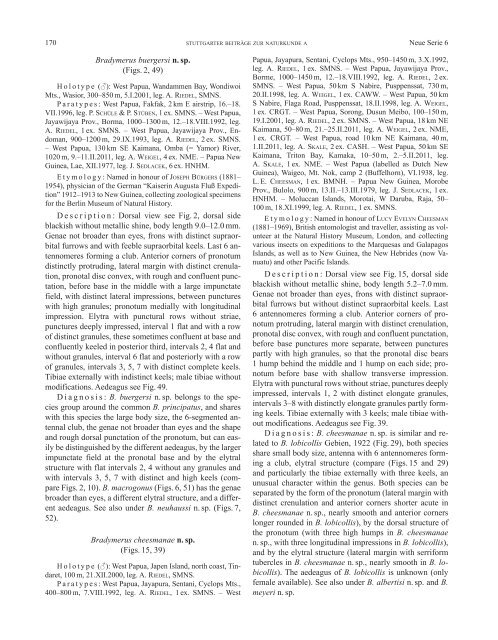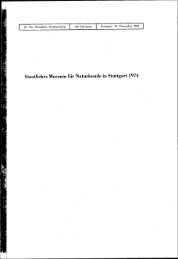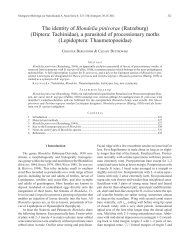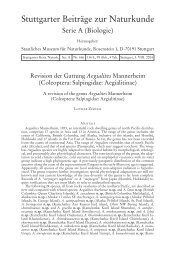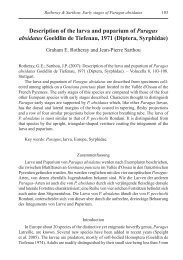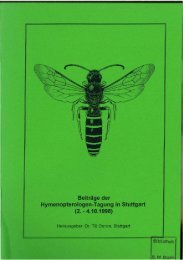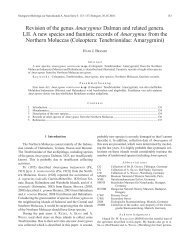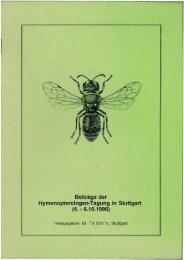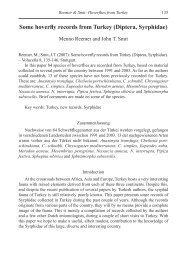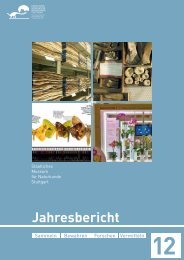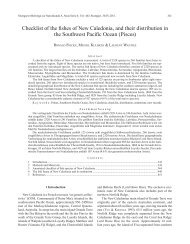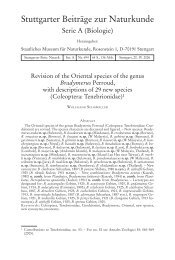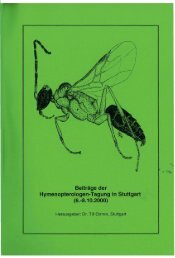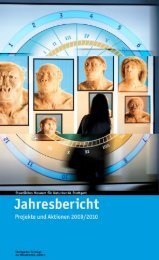The species of Bradymerus Perroud (Coleoptera: Tenebrionidae ...
The species of Bradymerus Perroud (Coleoptera: Tenebrionidae ...
The species of Bradymerus Perroud (Coleoptera: Tenebrionidae ...
You also want an ePaper? Increase the reach of your titles
YUMPU automatically turns print PDFs into web optimized ePapers that Google loves.
170 STUTTGARTER BEITRÄGE ZUR NATURKUNDE ANeue Serie 6<strong>Bradymerus</strong> buergersi n. sp.(Figs. 2, 49)Holotype (♂): West Papua, Wandammen Bay, WondiwoiMts., Wasior, 300–850 m, 5.I.2001, leg. A. RIEDEL, SMNS.Paratypes: West Papua, Fakfak, 2 km E airstrip, 16.–18.VII.1996, leg. P. SCHÜLE & P. STÜBEN, 1 ex. SMNS. – West Papua,Jayawijaya Prov., Borma, 1000–1300 m, 12.–18.VIII.1992, leg.A. RIEDEL, 1 ex. SMNS. – West Papua, Jayawijaya Prov., Endoman,900–1200 m, 29.IX.1993, leg. A. RIEDEL, 2 ex. SMNS.– West Papua, 130 km SE Kaimana, Omba (= Yamor) River,1020 m, 9.–11.II.2011, leg. A. WEIGEL, 4 ex. NME. – Papua NewGuinea, Lae, XII.1977, leg. J. SEDLACEK, 6 ex. HNHM.Etymology: Named in honour <strong>of</strong> JOSEPH BÜRGERS (1881–1954), physician <strong>of</strong> the German “Kaiserin Augusta Fluß Expedition”1912–1913 to New Guinea, collecting zoological specimensfor the Berlin Museum <strong>of</strong> Natural History.Description: Dorsal view see Fig. 2, dorsal sideblackish without metallic shine, body length 9.0–12.0 mm.Genae not broader than eyes, frons with distinct supraorbitalfurrows and with feeble supraorbital keels. Last 6 antennomeresforming a club. Anterior corners <strong>of</strong> pronotumdistinctly protruding, lateral margin with distinct crenulation,pronotal disc convex, with rough and confluent punctation,before base in the middle with a large impunctatefield, with distinct lateral impressions, between punctureswith high granules; pronotum medially with longitudinalimpression. Elytra with punctural rows without striae,punctures deeply impressed, interval 1 flat and with a row<strong>of</strong> distinct granules, these sometimes confluent at base andconfluently keeled in posterior third, intervals 2, 4 flat andwithout granules, interval 6 flat and posteriorly with a row<strong>of</strong> granules, intervals 3, 5, 7 with distinct complete keels.Tibiae externally with indistinct keels; male tibiae withoutmodifications. Aedeagus see Fig. 49.Diagnosis: B. buergersi n. sp. belongs to the <strong>species</strong>group around the common B. principatus, and shareswith this <strong>species</strong> the large body size, the 6-segmented antennalclub, the genae not broader than eyes and the shapeand rough dorsal punctation <strong>of</strong> the pronotum, but can easilybe distinguished by the different aedeagus, by the largerimpunctate field at the pronotal base and by the elytralstructure with flat intervals 2, 4 without any granules andwith intervals 3, 5, 7 with distinct and high keels (compareFigs. 2, 10). B. macrogonus (Figs. 6, 51) has the genaebroader than eyes, a different elytral structure, and a differentaedeagus. See also under B. neuhaussi n. sp. (Figs. 7,52).<strong>Bradymerus</strong> cheesmanae n. sp.(Figs. 15, 39)Holotype (♂): West Papua, Japen Island, north coast, Tindaret,100 m, 21.XII.2000, leg. A. RIEDEL, SMNS.Paratypes: West Papua, Jayapura, Sentani, Cyclops Mts.,400–800 m, 7.VIII.1992, leg. A. RIEDEL, 1 ex. SMNS. – WestPapua, Jayapura, Sentani, Cyclops Mts., 950–1450 m, 3.X.1992,leg. A. RIEDEL, 1 ex. SMNS. – West Papua, Jayawijaya Prov.,Borme, 1000–1450 m, 12.–18.VIII.1992, leg. A. RIEDEL, 2 ex.SMNS. – West Papua, 50 km S Nabire, Pusppenssat, 730 m,20.II.1998, leg. A. WEIGEL, 1 ex. CAWW. – West Papua, 50 kmS Nabire, Flaga Road, Pusppenssat, 18.II.1998, leg. A. WEIGEL,1 ex. CRGT. – West Papua, Sorong, Dusun Meibo, 100–150 m,19.I.2001, leg. A. RIEDEL, 2 ex. SMNS. – West Papua, 18 km NEKaimana, 50–80 m, 21.–25.II.2011, leg. A. WEIGEL, 2 ex. NME,1 ex. CRGT. – West Papua, road 10 km NE Kaimana, 40 m,1.II.2011, leg. A. SKALE, 2 ex. CASH. – West Papua, 50 km SEKaimana, Triton Bay, Kamaka, 10–50 m, 2.–5.II.2011, leg.A. SKALE, 1 ex. NME. – West Papua (labelled as Dutch NewGuinea), Waigeo, Mt. Nok, camp 2 (Buffelhorn), VI.1938, leg.L. E. CHEESMAN, 1 ex. BMNH. – Papua New Guinea, MorobeProv., Bulolo, 900 m, 13.II.–13.III.1979, leg. J. SEDLACEK, 1 ex.HNHM. – Moluccan Islands, Morotai, W Daruba, Raja, 50–100 m, 18.XI.1999, leg. A. RIEDEL, 1 ex. SMNS.Etymology: Named in honour <strong>of</strong> LUCY EVELYN CHEESMAN(1881–1969), British entomologist and traveller, assisting as volunteerat the Natural History Museum, London, and collectingvarious insects on expeditions to the Marquesas and GalapagosIslands, as well as to New Guinea, the New Hebrides (now Vanuatu)and other Pacific Islands.Description: Dorsal view see Fig. 15, dorsal sideblackish without metallic shine, body length 5.2–7.0 mm.Genae not broader than eyes, frons with distinct supraorbitalfurrows but without distinct supraorbital keels. Last6 antennomeres forming a club. Anterior corners <strong>of</strong> pronotumprotruding, lateral margin with distinct crenulation,pronotal disc convex, with rough and confluent punctation,before base punctures more separate, between puncturespartly with high granules, so that the pronotal disc bears1 hump behind the middle and 1 hump on each side; pronotumbefore base with shallow transverse impression.Elytra with punctural rows without striae, punctures deeplyimpressed, intervals 1, 2 with distinct elongate granules,intervals 3–8 with distinctly elongate granules partly formingkeels. Tibiae externally with 3 keels; male tibiae withoutmodifications. Aedeagus see Fig. 39.Diagnosis: B. cheesmanae n. sp. is similar and relatedto B. lobicollis Gebien, 1922 (Fig. 29), both <strong>species</strong>share small body size, antenna with 6 antennomeres forminga club, elytral structure (compare (Figs. 15 and 29)and particularly the tibiae externally with three keels, anunusual character within the genus. Both <strong>species</strong> can beseparated by the form <strong>of</strong> the pronotum (lateral margin withdistinct crenulation and anterior corners shorter acute inB. cheesmanae n. sp., nearly smooth and anterior cornerslonger rounded in B. lobicollis), by the dorsal structure <strong>of</strong>the pronotum (with three high humps in B. cheesmanaen. sp., with three longitudinal impressions in B. lobicollis),and by the elytral structure (lateral margin with serriformtubercles in B. cheesmanae n. sp., nearly smooth in B. lobicollis).<strong>The</strong> aedeagus <strong>of</strong> B. lobicollis is unknown (onlyfemale available). See also under B. albertisi n. sp. and B.meyeri n. sp.


